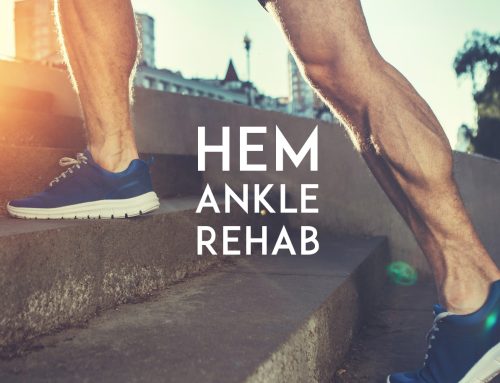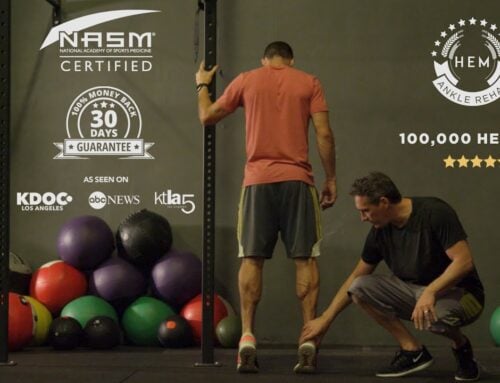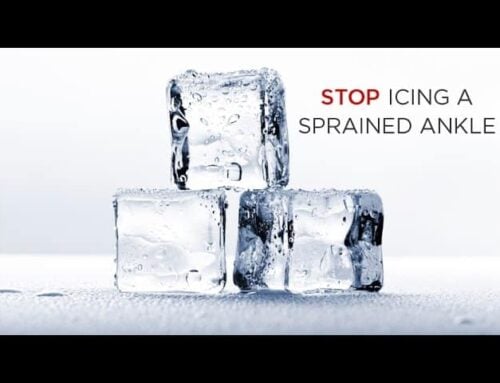
Walking is one of the most accessible and beneficial forms of exercise. It’s a low-impact activity that can be enjoyed by people of all ages and fitness levels. However, to get the most out of your walking routine, it’s essential to wear the right shoes. The wrong footwear can lead to discomfort, injury, and long-term issues, particularly if you have weak or unstable ankles.
In this guide, we’ll explore the best walking shoes on the market, discuss the importance of ankle support, and highlight why HEM Ankle Rehab is a superior treatment for ankle issues, steering clear of the outdated R.I.C.E. method.
What Type of Shoes Are Best for Walking?
When it comes to walking shoes, the most important factors are comfort, support, and durability. Unlike running shoes, which are designed for forward motion and impact absorption, walking shoes should provide a balance between cushioning and stability. Here are some key features to look for:
- Arch Support: Proper arch support is crucial for maintaining the natural alignment of your feet, which can prevent pain and injury. Whether you have flat feet, high arches, or neutral arches, choose a shoe that matches your specific needs.
- Cushioning: While walking doesn’t involve the same high-impact forces as running, cushioning is still important to protect your feet from the repeated pressure of each step. Look for shoes with ample cushioning in the heel and forefoot.
- Flexibility: Walking requires a good range of motion, so your shoes should be flexible enough to move with your foot. The sole should bend easily at the ball of the foot, allowing for a natural stride.
- Breathability: Keeping your feet cool and dry is essential, especially during long walks. Shoes with breathable mesh uppers can help prevent sweat buildup and reduce the risk of blisters.
- Stability: If you have weak or unstable ankles, stability is a key concern. Shoes with a firm heel counter and supportive midsole can help keep your foot in place and reduce the risk of rolling your ankle.
What Are the Best Walking Shoes Recommended by Podiatrists?
Podiatrists often recommend walking shoes based on their ability to provide both comfort and support. Here are some of the top choices that podiatrists frequently endorse:
- Brooks Addiction Walker: Known for its exceptional arch support and cushioning, the Brooks Addiction Walker is a top pick for those with flat feet or overpronation. It offers a stable ride with a durable, slip-resistant outsole.
- New Balance 928v3: The New Balance 928v3 is another podiatrist-recommended shoe that provides excellent stability and motion control. It features a Rollbar technology that helps minimize rearfoot movement, making it ideal for those with unstable ankles.
- Asics Gel-Nimbus 23: While primarily a running shoe, the Asics Gel-Nimbus 23 is also great for walking, thanks to its superior cushioning and shock absorption. The shoe’s Gel technology reduces impact on your joints, making it a comfortable choice for long walks.
- Saucony Echelon Walker 3: This shoe is a favorite among podiatrists for its roomy fit, which accommodates orthotics. The Saucony Echelon Walker 3 offers balanced cushioning and a stable base, making it suitable for people with various foot conditions.
- Hoka One One Bondi SR: Hoka is renowned for its maximalist approach to cushioning, and the Bondi SR is no exception. It provides plush comfort and stability, making it a great option for individuals who spend a lot of time on their feet.
Is It OK to Wear Running Shoes for Walking?
Many people wonder if they can wear running shoes for walking, and the answer is generally yes. Running shoes are designed to withstand higher impact forces and offer good cushioning, which can be beneficial for walking. However, there are some key differences to consider:
- Heel Height: Running shoes often have a higher heel-to-toe drop, which can encourage a forward-leaning posture. While this is ideal for running, it may not be as beneficial for walking, where a more neutral posture is preferred.
- Flexibility: Running shoes are usually more flexible at the forefoot, which is great for running but can be too soft for walking. Walking shoes, on the other hand, are designed to be more rigid to support a rolling gait.
- Durability: Since walking shoes are specifically designed for the repetitive motion of walking, they may last longer than running shoes if used exclusively for walking. Running shoes, while durable, are often subject to different wear patterns.
In summary, while running shoes can be used for walking, it’s important to choose a pair that provides adequate support and aligns with your walking biomechanics.
Are Skechers Shoes Good for Walking?
Skechers has become a popular brand for walking shoes, thanks to their comfort-focused designs. However, their suitability for walking depends on the specific model. Some Skechers shoes are designed with ample cushioning and support, making them a good option for walking, while others may be too soft or lack sufficient arch support.
Key Features of Skechers Walking Shoes:
- Memory Foam: Many Skechers walking shoes feature memory foam insoles, which provide a cushioned feel. However, memory foam can sometimes compress too much over time, leading to a loss of support.
- Lightweight Design: Skechers shoes are often lightweight, making them comfortable for long walks. However, lighter shoes may lack the stability needed for individuals with weak or unstable ankles.
- Affordable Price Point: Skechers walking shoes are generally more affordable than other brands, making them accessible to a wide range of consumers. However, it’s important to ensure that you’re not compromising on support and durability.
For those with weak or unstable ankles, it’s crucial to select a Skechers model that offers good arch support and a stable platform. While Skechers can be a comfortable and budget-friendly option, it’s worth considering whether they meet your specific needs for ankle stability and overall foot support.
Weak and Unstable Ankles: Why HEM Ankle Rehab is the Best Treatment
Weak and unstable ankles are a common issue, especially for those who have experienced previous ankle injuries or sprains. Traditional treatments like R.I.C.E. (rest, ice, compression, elevation) have been widely recommended for ankle injuries, but recent research suggests that more active rehabilitation approaches can lead to better outcomes.
Why Avoid R.I.C.E.?
The R.I.C.E. method focuses on reducing inflammation and immobilizing the ankle, but this can sometimes hinder the healing process by limiting circulation and delaying the restoration of full function. Instead, active rehabilitation, which involves movement and targeted exercises, can help strengthen the ankle and improve stability more effectively.
The Benefits of HEM Ankle Rehab:
HEM Ankle Rehab is an at-home program designed to heal both new and old ankle injuries, including ankle sprains, weak ankles, and chronic ankle pain and swelling. Unlike R.I.C.E., HEM Ankle Rehab focuses on restoring mobility, strength, and stability through a series of exercises and techniques.
- Mobility: The program includes specific exercises to improve the range of motion in the ankle, helping to prevent stiffness and promote faster healing.
- Strength: HEM Ankle Rehab targets the muscles around the ankle, strengthening them to provide better support and reduce the risk of future injuries.
- Stability: Balance and proprioception exercises are a key component of the program, helping to retrain the ankle to respond to uneven surfaces and sudden movements.
By following the HEM Ankle Rehab program, individuals can achieve a more complete recovery and reduce the likelihood of re-injury, making it an essential tool for anyone with weak or unstable ankles.
For those interested in learning more about ankle health and recovery, the following resources may be helpful:
Secret of the Pros
Everything You Need To Heal At Home
So, Why Rehab?
Most people think rest and ice will heal their ankle (even a severe sprain), but they end up with chronic ankle instability… 30% still have pain one year later!
And that causes all kinds of muscle imbalances in the body, which can lead more serious injuries, repeated ankle sprains and chronic ankle pain. It’s a terrible domino effect that can last for life.
That’s Where Rehab Comes In.
A great rehab program significantly improves how a sprained ankle heals. It eliminates pain fast and ensures your ankles are strong and stable with healthy range of motion, which helps prevent future sprains.
Rehab Is The Key To
Healing Ankle Injuries Fast
Recent studies have shown that rehab heals ankle ligaments safely and effectively. It’s the difference between the people that don’t heal a sprained ankle and the ones that do!
Injured Ankle
Without Rehab
Injured Ankle
With Rehab
HEM Ankle Rehab “Rehabs” Your Ankle

HEM is a complete ankle rehab and prehab program for the entire ankle, foot and calf complex. This is a very thorough program that contains so much more than anything else you can find online, but it’s still easy to do.
Scott will coach you through every step, as if you are with him, one on one. Just follow along with the videos to rebuild your ankle from the ground up.
You can expect pain free mobility and strong, stable ankles that are protected from an ankle sprain, without ankle braces!
REAL PEOPLE, REAL RESULTS
From Scott Malin, NASM-CPT, CES
Creator, HEM Ankle Rehab
October 24, 2025
Fifteen years ago, I had to give up what I love doing most… playing basketball. I sprained my ankles so many times that I could no longer play. It was devastating.
Like you, I used R.I.C.E. (rest, ice elevation, compression), but my ankles healed so slowly and badly, they eventually got so weak, I would sprain them just walking down the street!
Being a fitness trainer, the only thing I had going for me was a fascination with helping people get out of pain and strengthening their bodies.
So, I decided to research all the cutting edge techniques to heal an ankle sprain much faster and better than R.I.C.E.
After months of research, I discovered that icing an injury can have a negative affect on the body’s healing process. Studies show that ice can actually slow down healing and too much rest left the ankles weak and unstable. This was shocking, but only part of the story…
New research was suggesting a much more proactive approach to healing that involved much better rehab techniques proven to dramatically speed up the speed and quality of the healing process.
Instead of months, healing took only days. And, if you had a chronically weak ankle that was in pain, these techniques would quickly strengthen and stabilize the ankles.
I kept improving on these techniques, drawing from many different disciplines and simplified them.
Eventually, after many more months of trial and error, I created a simple at-home healing system with very reliable results.
Since I was a fitness trainer, I was able to help all my clients (celebrities and athletes) whenever they got injured. I was even on the news a few times.
The response from my clients and friends was so overwhelming that a few of them eventually convinced me to share it with everyone.
Today, I am humbled that over 100,000 people have healed fully and fast with my program.
So, if you have any kind of ankle injury (new or old), just follow along with me in the videos and I’ll show you exactly what to do until you are completely pain free.
My message is simple… you do not have to give up what you love. And you do not have to live with chronic pain from old injuries. Life is too short and there is a better way!
I truly hope you will start using my program so you can get your life back and do what you love, pain free (and yes, I still play basketball every week and LOVE it!)
Thank you!
Scott
Heal Your Ankle FAST ⇣

30 day money back guarantee
15 YEARS. 100K HEALED.

Secret of the Pros
Everything You Need To Heal At Home
REAL PEOPLE,
REAL RESULTS
So, Why Rehab?
Most people think rest and ice will heal their ankle (even a severe sprain), but they end up with chronic ankle instability… 30% still have pain one year later!
And that causes all kinds of muscle imbalances in the body, which can lead more serious injuries, repeated ankle sprains and chronic ankle pain. It’s a terrible domino effect that can last for life.
That’s Where Rehab Comes In.
A great rehab program significantly improves how a sprained ankle heals. It eliminates pain fast and ensures your ankles are strong and stable with healthy range of motion, which helps prevent future sprains.

Rehab Is The Key To
Healing Ankle Injuries Fast
Recent studies have shown that rehab heals ankle ligaments safely and effectively. It’s the difference between the people that don’t heal a sprained ankle and the ones that do!
Injured Ankle
Without Rehab
Injured Ankle
With Rehab
HEM Ankle Rehab
“Rehabs” Your Ankle

HEM is a complete ankle rehab and prehab program for the entire ankle, foot and calf complex. This is a very thorough program that contains so much more than anything else you can find online, but it’s still easy to do.
Scott will coach you through every step, as if you are with him, one on one. Just follow along with the videos to rebuild your ankle from the ground up.
You can expect pain free mobility and strong, stable ankles that are protected from an ankle sprain, without ankle braces!
100,000 PEOPLE HEALED-
-
-
-
-
-
-
-
-
-
-
-
-
-
-
-
-
-
From Scott Malin, NASM-CPT, CES
Creator, HEM Ankle Rehab
October 24, 2025
Fifteen years ago, I had to give up what I love doing most… playing basketball. I sprained my ankles so many times that I could no longer play. It was devastating.
Like you, I used R.I.C.E. (rest, ice elevation, compression), but my ankles healed so slowly and badly, they eventually got so weak, I would sprain them just walking down the street!
Being a fitness trainer, the only thing I had going for me was a fascination with helping people get out of pain and strengthening their bodies.
So, I decided to research all the cutting edge techniques to heal an ankle sprain much faster and better than R.I.C.E.
After months of research, I discovered that icing an injury can have a negative affect on the body’s healing process. Studies show that ice can actually slow down healing and too much rest left the ankles weak and unstable. This was shocking, but only part of the story…
New research was suggesting a much more proactive approach to healing that involved much better rehab techniques proven to dramatically speed up the speed and quality of the healing process.
Instead of months, healing took only days. And, if you had a chronically weak ankle that was in pain, these techniques would quickly strengthen and stabilize the ankles.
I kept improving on these techniques, drawing from many different disciplines and simplified them.
Eventually, after many more months of trial and error, I created a simple at-home healing system with very reliable results.
Since I was a fitness trainer, I was able to help all my clients (celebrities and athletes) whenever they got injured. I was even on the news a few times.
The response from my clients and friends was so overwhelming that a few of them eventually convinced me to share it with everyone.
Today, I am humbled that over 100,000 people have healed fully and fast with my program.
So, if you have any kind of ankle injury (new or old), just follow along with me in the videos and I’ll show you exactly what to do until you are completely pain free.
My message is simple… you do not have to give up what you love. And you do not have to live with chronic pain from old injuries. Life is too short and there is a better way!
I truly hope you will start using my program so you can get your life back and do what you love, pain free (and yes, I still play basketball every week and LOVE it!)
Thank you!
Scott
Hurry, sale ends soon!
30 day money back guarantee



























